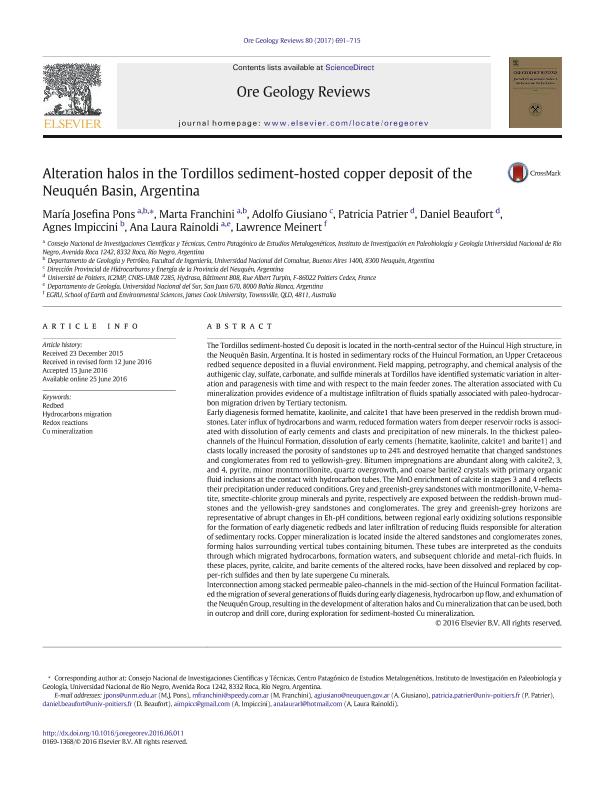Artículo
Alteration halos in the Tordillos sediment-hosted copper deposit of the Neuquén Basin, Argentina
Pons, María Josefina ; Franchini, Marta Beatriz
; Franchini, Marta Beatriz ; Giusiano, Adolfo Eugenio; Patrier, Patricia; Beaufort, Daniel; Impiccini, Agnes; Rainoldi, Ana Laura
; Giusiano, Adolfo Eugenio; Patrier, Patricia; Beaufort, Daniel; Impiccini, Agnes; Rainoldi, Ana Laura ; Meinert, Lawrence
; Meinert, Lawrence
 ; Franchini, Marta Beatriz
; Franchini, Marta Beatriz ; Giusiano, Adolfo Eugenio; Patrier, Patricia; Beaufort, Daniel; Impiccini, Agnes; Rainoldi, Ana Laura
; Giusiano, Adolfo Eugenio; Patrier, Patricia; Beaufort, Daniel; Impiccini, Agnes; Rainoldi, Ana Laura ; Meinert, Lawrence
; Meinert, Lawrence
Fecha de publicación:
01/2017
Editorial:
Elsevier Science
Revista:
Ore Geology Reviews
ISSN:
0169-1368
Idioma:
Inglés
Tipo de recurso:
Artículo publicado
Clasificación temática:
Resumen
The Tordillos sediment-hosted Cu deposit is located in the north-central sector of the Huincul High structure, in the Neuquén Basin, Argentina. It is hosted in sedimentary rocks of the Huincul Formation, an Upper Cretaceous redbed sequence deposited in a fluvial environment. Field mapping, petrography, and chemical analysis of the authigenic clay, sulfate, carbonate, and sulfide minerals at Tordillos have identified systematic variation in alteration and paragenesis with time and with respect to the main feeder zones. The alteration associated with Cu mineralization provides evidence of a multistage infiltration of fluids spatially associated with paleo-hydrocarbon migration driven by Tertiary tectonism. Early diagenesis formed hematite, kaolinite, and calcite1 that have been preserved in the reddish brown mudstones. Later influx of hydrocarbons and warm, reduced formation waters from deeper reservoir rocks is associated with dissolution of early cements and clasts and precipitation of new minerals. In the thickest paleo-channels of the Huincul Formation, dissolution of early cements (hematite, kaolinite, calcite1 and barite1) and clasts locally increased the porosity of sandstones up to 24% and destroyed hematite that changed sandstones and conglomerates from red to yellowish-grey. Bitumen impregnations are abundant along with calcite2, 3, and 4, pyrite, minor montmorillonite, quartz overgrowth, and coarse barite2 crystals with primary organic fluid inclusions at the contact with hydrocarbon tubes. The MnO enrichment of calcite in stages 3 and 4 reflects their precipitation under reduced conditions. Grey and greenish-grey sandstones with montmorillonite, V-hematite, smectite-chlorite group minerals and pyrite, respectively are exposed between the reddish-brown mudstones and the yellowish-grey sandstones and conglomerates. The grey and greenish-grey horizons are representative of abrupt changes in Eh-pH conditions, between regional early oxidizing solutions responsible for the formation of early diagenetic redbeds and later infiltration of reducing fluids responsible for alteration of sedimentary rocks. Copper mineralization is located inside the altered sandstones and conglomerates zones, forming halos surrounding vertical tubes containing bitumen. These tubes are interpreted as the conduits through which migrated hydrocarbons, formation waters, and subsequent chloride and metal-rich fluids. In these places, pyrite, calcite, and barite cements of the altered rocks, have been dissolved and replaced by copper-rich sulfides and then by late supergene Cu minerals. Interconnection among stacked permeable paleo-channels in the mid-section of the Huincul Formation facilitated the migration of several generations of fluids during early diagenesis, hydrocarbon up flow, and exhumation of the Neuquén Group, resulting in the development of alteration halos and Cu mineralization that can be used, both in outcrop and drill core, during exploration for sediment-hosted Cu mineralization.
Palabras clave:
Cu Mineralization
,
Hydrocarbons Migration
,
Redbed
,
Redox Reactions
Archivos asociados
Licencia
Identificadores
Colecciones
Articulos(IIPG)
Articulos de INSTITUTO DE INVESTIGACION EN PALEOBIOLOGIA Y GEOLOGIA
Articulos de INSTITUTO DE INVESTIGACION EN PALEOBIOLOGIA Y GEOLOGIA
Citación
Pons, María Josefina; Franchini, Marta Beatriz; Giusiano, Adolfo Eugenio; Patrier, Patricia; Beaufort, Daniel; et al.; Alteration halos in the Tordillos sediment-hosted copper deposit of the Neuquén Basin, Argentina; Elsevier Science; Ore Geology Reviews; 80; 1-2017; 691-715
Compartir
Altmétricas



